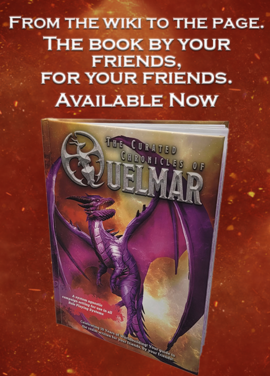Spiderjjr45 (talk | contribs) m (Text replacement - "^(?!{{Worldbuilders}})" to "{{Worldbuilders}}") |
Spiderjjr45 (talk | contribs) m (The LinkTitles extension automatically added links to existing pages (https://github.com/bovender/LinkTitles).) |
||
| (3 intermediate revisions by 2 users not shown) | |||
| Line 2: | Line 2: | ||
== Physical Appearance == |
== Physical Appearance == |
||
A little taller than most humans, Thri-Kreens' extra long torsos provide the extra area needed for their second set of arms. A bit of thorax juts out behind them providing extra protection for their smaller legs while large mandibles make it impossible for them to speak Common, or any other language than their own. |
A little taller than most [[humans]], Thri-Kreens' extra long torsos provide the extra area needed for their second set of arms. A bit of thorax juts out behind them providing extra protection for their smaller legs while large mandibles make it impossible for them to speak [[Common]], or any other language than their own. |
||
What is most unusual about Thri-Kreen, however, is their lack of gender. They do not conform to any gendered social norm because they do not physically match the required characteristics. |
What is most unusual about Thri-Kreen, however, is their lack of gender. They do not conform to any gendered social norm because they do not physically match the required characteristics. |
||
| Line 9: | Line 9: | ||
Kreen have no lips or tongue and are unable to produce most traditional sounds. A different, hard chitin organ allows for a variation of clicks unable to be reproduced, in turn, by most traditional speakers. It is through this combination of clicks, pops, grinds, and glottal stops that a Kreen communicates with its kin. |
Kreen have no lips or tongue and are unable to produce most traditional sounds. A different, hard chitin organ allows for a variation of clicks unable to be reproduced, in turn, by most traditional speakers. It is through this combination of clicks, pops, grinds, and glottal stops that a Kreen communicates with its kin. |
||
Kreen eat nearly any living animal, but prefer non-kreen, reptiles, birds, and other non-insects. They prefer herbivores to carnivores. Kreen never eat plants but are happy cooks who use spices to flavor or preserve meats (and sometimes use as medicine). Kreen prefer unintelligent prey, but seldom do hunt intelligent species. Elves are their favorite of the humanoids, as their natural cunning and swift feet make for an exciting hunt. However, humanoids ultimately provide a smaller meal than natural beasts, and are eaten out of ceremony or necessity. |
Kreen eat nearly any living animal, but prefer non-kreen, reptiles, birds, and other non-insects. They prefer herbivores to carnivores. Kreen never eat plants but are happy cooks who use spices to flavor or preserve meats (and sometimes use as medicine). Kreen prefer unintelligent prey, but seldom do hunt intelligent species. [[Elves]] are their favorite of the humanoids, as their natural cunning and swift feet make for an exciting hunt. However, humanoids ultimately provide a smaller meal than natural beasts, and are eaten out of ceremony or necessity. |
||
== Organization: Clutches and Packs == |
== Organization: Clutches and Packs == |
||
| Line 15: | Line 15: | ||
=== Clutch === |
=== Clutch === |
||
A |
A versatile term, a clutch (or G'tok) is not only the term used for kreen who hatched from eggs that were laid together (known as a birth clutch) but also for a group of individuals which a kreen later accepts as its own close companions (known as clutchmates). Kreen individually can belong to several clutches, but get possessive when non-kreen decide to find allies in other clutches. But to a kreen, the birth clutch is the most special. |
||
Lone kreen separated from all others have been observed to find new clutchmates in whatever is available, building a strong and naive friendship with various races. But kreen can also be judgmental |
Lone kreen separated from all others have been observed to find new clutchmates in whatever is available, building a strong and naive friendship with various races. But kreen can also be judgmental: possible clutchmates who do not return the friendship are judged harshly and cast off from the clutch in the kreen's mind. However, those who protect and fight alongside a kreen are generally considered clutchmates immediately. |
||
=== Pack === |
=== Pack === |
||
Several clutches that interlink (see figure above) are known as a Pack. Most packs have less than 100 members and fewer than 12 clutches. Packs are typically identified by a group of clutches that share the same geographical land, share habits, and coexist peacefully. Kreen often identify themselves by the name of their pack. Packs that become too large often split |
Several clutches that interlink (see figure above) are known as a Pack. Most packs have less than 100 members and fewer than 12 clutches. Packs are typically identified by a group of clutches that share the same geographical land, share habits, and coexist peacefully. Kreen often identify themselves by the name of their pack. Packs that become too large often split. |
||
Packs have a leader, a packsecond, and a council clutch, who seek to mediate any troubles that arise between clutches or between clutchmates. Pack leadership is determined by challenges between clutch leaders. These challenges can be physical, mental, or spiritual in nature, but are only ever instigated when a new clutch (and clutch leader) are brought into a pack. |
Packs have a leader, a packsecond, and a council clutch, who seek to mediate any troubles that arise between clutches or between clutchmates. Pack leadership is determined by challenges between clutch leaders. These challenges can be physical, mental, or spiritual in nature, but are only ever instigated when a new clutch (and clutch leader) are brought into a pack. |
||
| Line 27: | Line 27: | ||
== Tactics == |
== Tactics == |
||
Natural hunters, Kreen stalk their prey with fatal precision. As |
Natural hunters, Kreen stalk their prey with fatal precision. As kreen do not sleep, they can cover ground over night while their targets rest. It is said that their stamina and speed rivals even the most well-bred humanoids. Like ninjas, they strike with precision and from surprise points. Killing prey in their sleep is an honored tactic, as is attacking a herd and picking off the weakest members. The strategy falls secondary to the success of a bountiful hunt. |
||
When hunting more intelligent or dangerous prey, |
When hunting more intelligent or dangerous prey, kreen hunt in tribes, getting as many willing clutchmates to join them as possible, and getting as many mandibles and claws into the combat as possible. |
||
== Kreen Terms == |
== Kreen Terms == |
||
| Line 53: | Line 53: | ||
* '''Tikchak''': Hunt-Minded |
* '''Tikchak''': Hunt-Minded |
||
* '''Tokchak''': Egg-Minded |
* '''Tokchak''': Egg-Minded |
||
[[Category:SotS Inc]] |
|||
[[Category:Monsters]] |
|||
Latest revision as of 17:57, 17 August 2024
The Thri-Kreen (Translated: Wanderer-Person) are one of two sub-race of Kreen, the other being the slightly larger Tohr-Kree (Translated: Settled-Person).
Physical Appearance[edit | edit source]
A little taller than most humans, Thri-Kreens' extra long torsos provide the extra area needed for their second set of arms. A bit of thorax juts out behind them providing extra protection for their smaller legs while large mandibles make it impossible for them to speak Common, or any other language than their own.
What is most unusual about Thri-Kreen, however, is their lack of gender. They do not conform to any gendered social norm because they do not physically match the required characteristics.
Speech and Diet[edit | edit source]
Kreen have no lips or tongue and are unable to produce most traditional sounds. A different, hard chitin organ allows for a variation of clicks unable to be reproduced, in turn, by most traditional speakers. It is through this combination of clicks, pops, grinds, and glottal stops that a Kreen communicates with its kin.
Kreen eat nearly any living animal, but prefer non-kreen, reptiles, birds, and other non-insects. They prefer herbivores to carnivores. Kreen never eat plants but are happy cooks who use spices to flavor or preserve meats (and sometimes use as medicine). Kreen prefer unintelligent prey, but seldom do hunt intelligent species. Elves are their favorite of the humanoids, as their natural cunning and swift feet make for an exciting hunt. However, humanoids ultimately provide a smaller meal than natural beasts, and are eaten out of ceremony or necessity.
Organization: Clutches and Packs[edit | edit source]
Clutch[edit | edit source]
A versatile term, a clutch (or G'tok) is not only the term used for kreen who hatched from eggs that were laid together (known as a birth clutch) but also for a group of individuals which a kreen later accepts as its own close companions (known as clutchmates). Kreen individually can belong to several clutches, but get possessive when non-kreen decide to find allies in other clutches. But to a kreen, the birth clutch is the most special.
Lone kreen separated from all others have been observed to find new clutchmates in whatever is available, building a strong and naive friendship with various races. But kreen can also be judgmental: possible clutchmates who do not return the friendship are judged harshly and cast off from the clutch in the kreen's mind. However, those who protect and fight alongside a kreen are generally considered clutchmates immediately.
Pack[edit | edit source]
Several clutches that interlink (see figure above) are known as a Pack. Most packs have less than 100 members and fewer than 12 clutches. Packs are typically identified by a group of clutches that share the same geographical land, share habits, and coexist peacefully. Kreen often identify themselves by the name of their pack. Packs that become too large often split.
Packs have a leader, a packsecond, and a council clutch, who seek to mediate any troubles that arise between clutches or between clutchmates. Pack leadership is determined by challenges between clutch leaders. These challenges can be physical, mental, or spiritual in nature, but are only ever instigated when a new clutch (and clutch leader) are brought into a pack.
Packs do not consider non-kreen as part of the pack, despite their membership in a member clutch.
Tactics[edit | edit source]
Natural hunters, Kreen stalk their prey with fatal precision. As kreen do not sleep, they can cover ground over night while their targets rest. It is said that their stamina and speed rivals even the most well-bred humanoids. Like ninjas, they strike with precision and from surprise points. Killing prey in their sleep is an honored tactic, as is attacking a herd and picking off the weakest members. The strategy falls secondary to the success of a bountiful hunt.
When hunting more intelligent or dangerous prey, kreen hunt in tribes, getting as many willing clutchmates to join them as possible, and getting as many mandibles and claws into the combat as possible.
Kreen Terms[edit | edit source]
- Ak: Combat
- Chakak: Psionicist
- Chatkcha: Three-bladed throwing wedge
- Chil: Biochemical science
- Dra: Mammal person (m: draj, f: dras)
- Dre: Death
- G: Family, blood
- G'tok: Clutch
- G'tok-dra: A clutch that includes mammal people.
- Gythka: Two-bladed fighting staff
- Hoz: Leader
- Kak: Warrior
- Kcha: To kill, killer
- Kik: Raiders, thieves, pirates
- Kyor: Avenger, revenger
- Na: Night
- No: Day
- Sa: Home
- Tho: Life
- Tikchak: Hunt-Minded
- Tokchak: Egg-Minded

